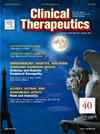新生儿呼吸窘迫综合征婴儿 INtubation-SURfactant-Extubation 失败的风险因素。
IF 3.2
4区 医学
Q2 PHARMACOLOGY & PHARMACY
引用次数: 0
摘要
目的:确定可预测 INtubation-SURfactant-Extubation (INSURE) 策略失败或成功的临床特征,以区分哪些婴儿可采用该策略防止机械通气 (MV):方法:有胎龄的婴儿:77 名婴儿(20.7%)的 INSURE 未成功。与 INSURE 成功组相比,INSURE 失败组婴儿的严重呼吸窘迫综合征发生率较高,表现为放射学分级;血液 pH 值、氧分压和碱过量 (BE) 水平较低;首次动脉血气分析时二氧化碳分压水平较高;1 分钟和 5 分钟的 Apgar 评分较低;产前类固醇用量较少;妊娠糖尿病发生率较高。多元回归分析证实,严重的放射学分级、首次动脉血气分析时较低的BE水平和较少使用产前类固醇是INSURE失败的独立风险因素。与 INSURE 成功组的婴儿相比,INSURE 失败组的婴儿死亡率也更高:我们成功确定了 INSURE 策略失败的特定预测因素。在使用表面活性物质后,对有一个或多个预测因素的高危早产儿继续插管并使用中压治疗,可防止再次插管并降低死亡率。本文章由计算机程序翻译,如有差异,请以英文原文为准。
Risk Factors for INtubation-SURfactant-Extubation Failure in Infants With Neonatal Respiratory Distress Syndrome
Purpose
To identify clinical characteristics predictive of failure or success of the INtubation-SURfactant-Extubation (INSURE) strategy, to distinguish infants who could be managed using this strategy to prevent mechanical ventilation (MV).
Methods
Infants with a gestational age <32 weeks were classified into two groups according to whether they required reintubation and MV within 72 h after birth. The clinical characteristics of the two groups were subsequently analyzed.
Results
INSURE was unsuccessful in 77 infants (20.7%). Infants in the INSURE failure group had a higher incidence of severe respiratory distress syndrome, as evidenced by radiological grade; lower blood pH, partial oxygen pressure, and base excess (BE) levels; higher partial carbon dioxide pressure levels at the first arterial blood gas analysis; lower Apgar scores at 1 and 5 min; lower use of antenatal steroids; and higher occurrence of gestational diabetes mellitus, versus those in the INSURE success group. Multiple regression analysis confirmed severe radiological grade, lower BE levels at the first arterial blood gas analysis, and decreased use of antenatal steroids as independent risk factors for INSURE failure. Compared with infants in the INSURE success group, those in the INSURE failure group also had higher mortality.
Conclusions
We successfully identified specific predictors of an unsuccessful INSURE strategy. Maintaining high-risk preterm infants with one or several predictors intubated and treated with MV after surfactant administration can prevent reintubation and reduce mortality.
求助全文
通过发布文献求助,成功后即可免费获取论文全文。
去求助
来源期刊

Clinical therapeutics
医学-药学
CiteScore
6.00
自引率
3.10%
发文量
154
审稿时长
9 weeks
期刊介绍:
Clinical Therapeutics provides peer-reviewed, rapid publication of recent developments in drug and other therapies as well as in diagnostics, pharmacoeconomics, health policy, treatment outcomes, and innovations in drug and biologics research. In addition Clinical Therapeutics features updates on specific topics collated by expert Topic Editors. Clinical Therapeutics is read by a large international audience of scientists and clinicians in a variety of research, academic, and clinical practice settings. Articles are indexed by all major biomedical abstracting databases.
 求助内容:
求助内容: 应助结果提醒方式:
应助结果提醒方式:


